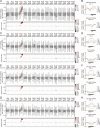Mitotic chromosome condensation resets chromatin to safeguard transcriptional homeostasis during interphase
- PMID: 36656860
- PMCID: PMC9942888
- DOI: 10.1073/pnas.2210593120
Mitotic chromosome condensation resets chromatin to safeguard transcriptional homeostasis during interphase
Abstract
Mitotic entry correlates with the condensation of the chromosomes, changes in histone modifications, exclusion of transcription factors from DNA, and the broad downregulation of transcription. However, whether mitotic condensation influences transcription in the subsequent interphase is unknown. Here, we show that preventing one chromosome to condense during mitosis causes it to fail resetting of transcription. Rather, in the following interphase, the affected chromosome contains unusually high levels of the transcription machinery, resulting in abnormally high expression levels of genes in cis, including various transcription factors. This subsequently causes the activation of inducible transcriptional programs in trans, such as the GAL genes, even in the absence of the relevant stimuli. Thus, mitotic chromosome condensation exerts stringent control on interphase gene expression to ensure the maintenance of basic cellular functions and cell identity across cell divisions. Together, our study identifies the maintenance of transcriptional homeostasis during interphase as an unexpected function of mitosis and mitotic chromosome condensation.
Keywords: cell cycle; chromatin; chromosomes; mitosis; transcription.
Conflict of interest statement
The authors declare no competing interest.
Figures





References
Publication types
MeSH terms
Substances
LinkOut - more resources
Full Text Sources
Molecular Biology Databases

